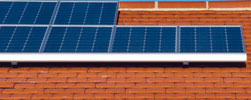

Solar panels generate power directly from the sun. They convert the sunlight that they draw directly into electricity; this form of power is friendly to the environment, as there are no harmful gases or chemicals that are used in producing this power. This is therefore better for the environment.
The solar panels are made up of a collection of individual silicon. A single solar cell can produce about 0,5 of a volt. Solar cells are grouped together to create a panel, which can produce up to 24 volts output. Solar panels can also be wired in parallel, this will increase the power output creating more power, and if wired in series, this will increase voltage for 24, 48 or possibly even higher voltage systems.
The three types of solar panels are monocrystalline, polycrystalline and amorphous. At present, PSS Distributers is concentrating on two types, monocrystalline and polycrystalline.
The differences between the panels are as follows:
Monocrystalline – All crystals face the same direction. This form of solar panel is the most effective, but the cost factor is a lot more expensive. Slices are cut at sizes of 0,2 and 0,4 mm thick. These are then put together as individual cells, wired together in the panel. Manufacturing temperature is around 1400 degrees Celsius.
Polycrystalline – Crystal faces have different directions, grains are not parallel and can also be called multi-crystalline. These panels are less expensive, but can also be less efficient. The cells are not single crystals but a block of many crystals. Manufacturing temperature is a bit lower than Monocrystalline at about 800-1000 degrees Celsius.
Amorphous – This is the angle of the adjustable solar panel, which can be changed two or more times during the year. This helps increase the solar output by approximately 25%.
When you have decided on the location of the solar panels, ensure you have a good amount of sunlight between the times of 9 am – 4 pm. It is not advised that solar panels be placed in the shade, but remember that heat build up can cause the panel to be less efficient. There should always be spacing around the panels, this will ensure that there is sufficient cooling and ensure that the panels do not build up to much heat.
Solar panels should always face the equator for effective coverage. So if living in the southern hemisphere, the solar panels would face in a northern direction. The angle of the panel should only be changed twice per year. In winter +15° latitude and in summer -15° latitude. This will increase the solar panels output by a further 25%.
Tracking solar panels are the most effective type as they follow the sun, but the cost of these units are expensive and during winter, may not be as effective. Solar panels are a more cost effective way of ensuring constant power as well as ensuring that the environment remains emission free and allows the environment to remain green.
| Tel: | +27 11 608 4259 |
| Email: | [email protected] |
| www: | www.pss.co.za |
| Articles: | More information and articles about PSS Distributors |
© Technews Publishing (Pty) Ltd. | All Rights Reserved.